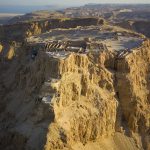Roman siege tower (called turris outpatient in Latin) was moved on round logs with the use of levers. It was usually a structure in the shape of a truncated pyramid with a wooden, grate structure, built on a square plan.
The front and sides of the tower were covered with boards, equipped with assault platforms and a battering ram. The towers were used to attack the walls of the besieged cities.
Depending on the type of ground on which the tower moved, the appropriate type of wheels was used – so the wheels were different when the tower was moved on the sand, and different when it was rolled on rocky ground.
Inside, in the lower part, there could be a battering ram, and the upper floors were used as positions for various throwing machines, archers and slingers. Very often, the front walls, upholstered with raw animal skins hindering fire, were equipped with lowered platforms that facilitated a direct attack on the crown of the walls. The resistance of the Roman siege towers was calculated against the impact of a stone ball weighing about 80 kg. From 87 BCE, the Romans subjected their structures to impregnation with alum solution, which additionally protected them against enemy incendiary projectiles
These machines, higher than the walls of the attacked fortress, played an extremely important role in the fight. On the one hand, they protected the besieging defenders against projectiles, and on the other, they allowed for direct attack, shooting at the inside of the fortress, breaking its walls, observing the battlefield or making trenches under the wall under their cover.
The use of towers in siege fights required levelling the terrain, removing obstacles, filling in the moats, and if the cities were located on hills, building a special ramp, called aggerem, which significantly extended the time needed to prepare an attack. Agger was an element of fortification that started in the early Roman Republic that was adopted later in the empire.
Although the siege towers (turres ambulatoriae) posed a serious threat to the defenders, there were many ways to fight them. To defend against siege towers, special cranes were used to carry barrels of burning tar and sulfur over the towers. In the place of the attack on the towers, special wooden scaffoldings were erected or smaller towers were built to raise the walls.








